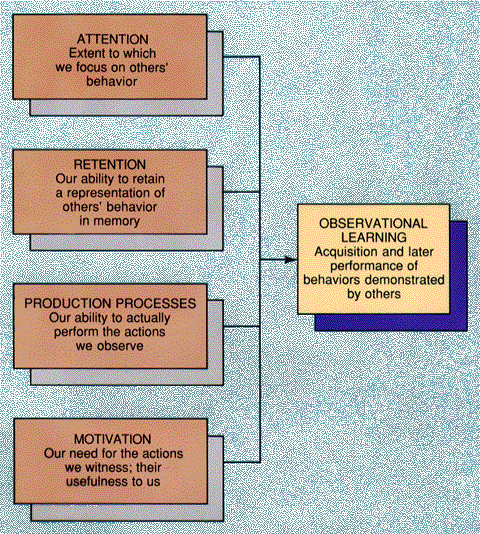We have all been to a conference or training, and attended a program where we were sure the content would change our lives. And then we went home and went back to our “old ways”. When I did my doctoral research I was struck by the work of many who identified progressive and sequential training as the key to success. Another common theme was the consistent use of the model developed by David Kolb, the Experiential Learning Model. All of this work indicates that real behavioral modification takes place over time. That’s the question we all have to answer – how much time is enough.
For us to maximize learning and performance we need to use this model again and again until we “meet standards” as a boss. The question then, is are you willing to make that time commitment.
The sad face of our organizations (and organizations in general) is that we promote for technical competence at the level a person is at and then hope  for the best. Do some stuff on your own. Find a role model and emulate them. Learn as you go. Go to Emmitsburg. Go to college. The list goes on, but there is a solution.
for the best. Do some stuff on your own. Find a role model and emulate them. Learn as you go. Go to Emmitsburg. Go to college. The list goes on, but there is a solution.
Build your people into learning machines and then send them out to get more training. In particular out Entry Level training programs should be a baseline for your bosses. This is the beginning of true competence. Then when our folks begin to build a rich archive of personal experiences and wins and losses – and learn from them, that’s improvement.
I also used Albert Bandura’s work on “Self Efficacy”, …our belief in our ability to succeed in certain situations. and his “Social Learning Theory” which in a nutshell is defined as…
Social Learning Concepts
There are three core concepts at the heart of social learning theory. First is the idea that people can learn through observation. Next is the idea that internal mental states are an essential part of this process. Finally, this theory recognizes that just because something has been learned, it does not mean that it will result in a change in behavior.
Let’s explore each of these concepts in greater depth.
1. People can learn through observation.
Observational Learning
In his famous Bobo doll experiment, Bandura demonstrated that children learn and imitate behaviors they have observed in other people. The children in Bandura’s studies observed an adult acting violently toward a Bobo doll. When the children were later allowed to play in a room with the Bobo doll, they began to imitate the aggressive actions they had previously observed.
Bandura identified three basic models of observational learning:
- A live model, which involves an actual individual demonstrating or acting out a behavior.
- A verbal instructional model, which involves descriptions and explanations of a behavior.
- A symbolic model, which involves real or fictional characters displaying behaviors in books, films, television programs, or online media.
2. Mental states are important to learning.
Intrinsic Reinforcement
Bandura noted that external, environmental reinforcement was not the only factor to influence learning and behavior. He described intrinsic reinforcement as a form of internal reward, such as pride, satisfaction, and a sense of accomplishment. This emphasis on internal thoughts and cognition helps connect learning theories to cognitive developmental theories. While many textbooks place social learning theory with behavioral theories, Bandura himself describes his approach as a ‘social cognitive theory.’
3. Learning does not necessarily lead to a change in behavior.
While behaviorists believed that learning led to a permanent change in behavior, observational learning demonstrates that people can learn new information without demonstrating new behaviors.
The Modeling Process
Not all observed behaviors are effectively learned. Factors involving both the model and the learner can play a role in whether social learning is successful. Certain requirements and steps must also be followed. The following steps are involved in the observational learning and modeling process:
- Attention:
In order to learn, you need to be paying attention. Anything that detracts your attention is going to have a negative effect on observational learning. If the model interesting or there is a novel aspect to the situation, you are far more likely to dedicate your full attention to learning.- Retention:
The ability to store information is also an important part of the learning process. Retention can be affected by a number of factors, but the ability to pull up information later and act on it is vital to observational learning.- Reproduction:
Once you have paid attention to the model and retained the information, it is time to actually perform the behavior you observed. Further practice of the learned behavior leads to improvement and skill advancement.- Motivation:
Finally, in order for observational learning to be successful, you have to be motivated to imitate the behavior that has been modeled. Reinforcement and punishment play an important role in motivation. While experiencing these motivators can be highly effective, so can observing other experience some type of reinforcement or punishment. For example, if you see another student rewarded with extra credit for being to class on time, you might start to show up a few minutes early each day.
Retrieved from http://psychology.about.com/od/developmentalpsychology/a/sociallearning.htm , 2013
This theory is the cornerstone of our design and delivery. The time for hoping for change is over. Let us make a difference together!
Fill out the contact form and let’s discuss how 21st Century Leaders can help you and your organization thrive!!

